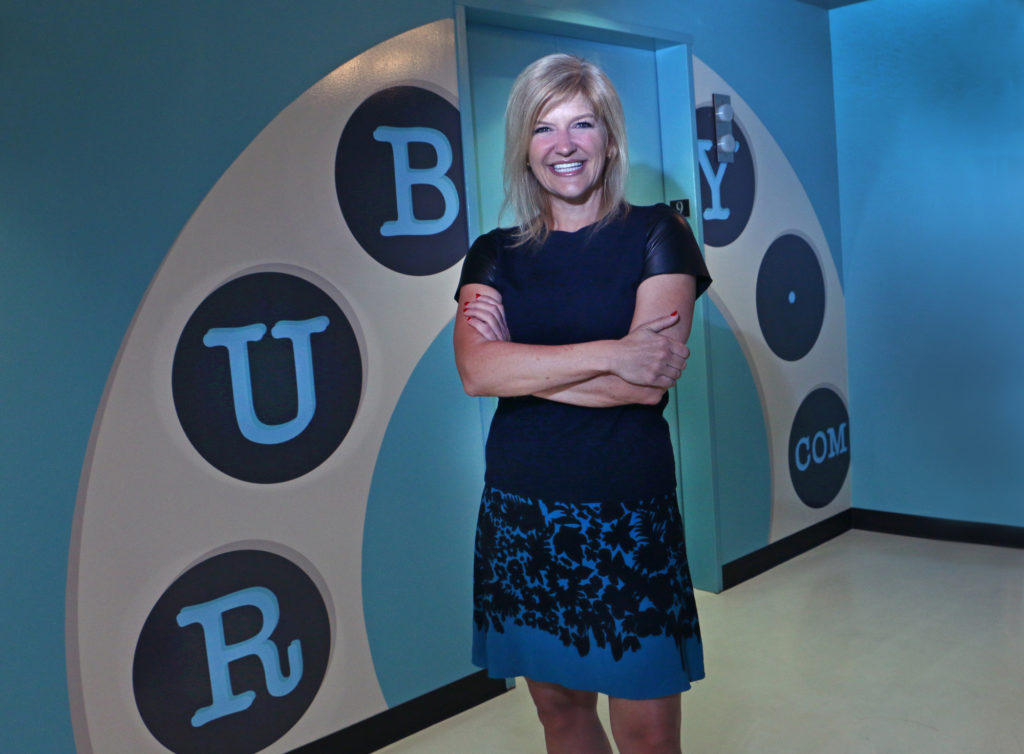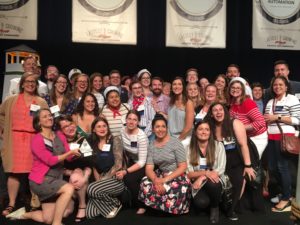Lessons Learned After 15 Years in Business
June 12, 2018
 Jill Nelson is the founder and CEO of Ruby® Receptionists, which recently reached its 15-year anniversary. Jill shared lessons learned and more in a blog post to mark the occasion. Below is an excerpt from the original article.
Jill Nelson is the founder and CEO of Ruby® Receptionists, which recently reached its 15-year anniversary. Jill shared lessons learned and more in a blog post to mark the occasion. Below is an excerpt from the original article.
I’m incredibly grateful for the amazing customers and employees who brought us to this milestone! To celebrate our anniversary, I’m sharing a few pivotal lessons I have learned during each of these wonderful years.
Whether you’re running a business, prepping to launch a startup, or dreaming of an entrepreneurial future, I hope these reflections help you on your journey!
2003 / Great service really does win business.
When I started Ruby, I truly believed we would help small businesses by taking an essential task—answering and handling phone calls—off their plates. I had been a receptionist in a former career, and I thought being friendly, listening, and doing whatever we could to provide a positive phone experience was simply table stakes for a business.
Our customers spoke up early and often: They let us know the Ruby caller experience was making a difference in their business’ success. Clients stuck around and referred new clients to us! Today, customer referrals remain the top source of new customers for us, and it brings me great personal joy to know we are helping other businesses grow by keeping alive that personal caller experience.
Bonus lesson: Don’t put your coffee machine, your microwave, and your telecommunications server on the same circuit.
2004 / Cash and financial management is a matter of survival.
We were off to the races with our WOW-worthy service. Even so, those first years of trying to get to scale were rough—and there were a few payroll runs that left mere pennies in our checking account. Had we waited for an outside bookkeeper to finish doing the books to know where we stood each month, we might not be here today.
When it was a matter of business life and death, I practiced daily cash management. Managing the timing of our cash outlays, projecting our inflows, knowing our break-even points, and understanding the difference between income on the books and positive cash flow were all part of this rigorous, business-saving process.
Ruby #2, Paddy McCaffrey-Allen, still teases me today about my passionate plea to not buy “even one pencil!”
I know many of you are in that cash-critical, ramp-up stage and rely on us to deliver value that exceeds our price. Our recent phone number feature additions were designed to help you eliminate a phone bill, and we are working to add more customized packages this year to more closely match our clients’ needs.
 2005 / Ask your employees for feedback.
2005 / Ask your employees for feedback.
You might know Ruby as an award-winning employer of choice, having been recognized nationally for years as a great place to work. I confess that wasn’t always the case.
It took us until year three to conduct our first employee survey. I was nervous! As a small business owner, the thought of someone not feeling valued at my company felt personal. But at the urging of an employee, I did it. And, while it was hard to read some of the comments, it served as the beginning of the journey to becoming the employer we are today.
The big takeaway from the survey was to regularly make sure each employee knew how they were making a difference—in the lives of our callers and customers, and in the success of Ruby. And the impact of employees who feel valued in the work they do? What happens when employees feel valued and part of a greater effort? Strong employee retention—which translated to more stability for customers—and a cohesive workforce that’s fired up to deliver on the mission.
2006 / Surprise! Other business owners are going through the same challenges that we are.
Being a business owner can be a lonely experience. Founders bear the weight of the success of the organization and the livelihood of employees. When faced with challenges, it’s not always appropriate to confide in our staff and friends with stable, paying jobs don’t seem to relate.
Do you sometimes feel that someone, somewhere, has already figured out the solution to the problem you’re facing? I certainly did. But in 2006, I found my peer group by joining the Entrepreneurs Organization—and it was a game-changer. The organization serve as an informal business advisory board. Getting a close look at the challenges other business owners face means I get to learn from their experiences.
Bonus lesson: Set your domain name to auto-renew!
2007 / KPIs and company dashboards help ensure your customers, employees and financial stakeholders are all being considered.
If you are ever in Portland and come by for the Ruby tour, ask someone to show you our performance dashboards. It surprises many people that a company so focused on people and service is ahead of the curve in data measurement and performance benchmarking.
But here’s the thing: Our dashboards are a critical tool for ensuring we are delivering to our customers and employees what we promise. At the start of 2007, KPIs and dashboards were foreign to us. It was after a desperate plea by our overworked receptionists that I dug into the data. There, I discovered we had grown our customer count far faster than our employees to support it, and customer service and employee happiness were suffering.
Today our dashboards are built with a “balanced scorecard” approach—measuring performance, service quality, customer happiness and employee happiness all on the same page. Our KPIs aren’t meant to be punitive, but just like the warning lights on your car’s dashboard, a red KPI signals that a key function might be out of whack, and this alert can save us from a breakdown.
Bonus lesson: Mistakes are the fertile ground of innovation!
…
2009: Know what you stand for and surround yourself with people who are aligned with that mission.
 We grew our customer count 30% in 2009. The strategy of 2008 serves as a pivotal lesson of our 15-year life. We took those lessons, and from them, built our formal mission, vision, and values. You can read them here.
We grew our customer count 30% in 2009. The strategy of 2008 serves as a pivotal lesson of our 15-year life. We took those lessons, and from them, built our formal mission, vision, and values. You can read them here.
Today, those guiding principles help us attract and retain employees. They help us make business decisions. And they help us stay focused on delivering our customers the service they expect and deserve.
2010: Every touchpoint matters.
One day, as I was deeply engaged with whatever was on my computer screen, I was interrupted by a knock on my open office door. I looked up to find not a fellow Ruby, but an acquaintance and potential customer standing in the doorway. “Funny,” he said. “The receptionist company has no receptionist. I wandered around your office to eventually find you without so much as a ‘hello!’”
Ouch! That day, I realized your brand and your vision don’t just show up in the service you provide. It shows up everywhere: how you greet people in your office, how your website looks, how your physical office looks, and even how you and your employees show up in the community. Longtime Ruby and customer experience evangelist Christina Burns, our VP of Customer Success, wrote an awesome e-book on how to ensure every communication across your touchpoints are delivering a great experience.
…
2013: The achievement of a long-term goal can be accomplished with clear metrics, a path and a team who is aligned and focused.
Back in 2008, our team did a vision exercise: What would Ruby look like at 10 times our current size? What would our culture look like? Our offering? How many employees would we have? Customers? What would our jobs look like? Our benefits? The vision exercise was followed by another exercise to explore what it might take to achieve that vision. Those two exercises created an excitement towards achieving the vision of growing by 10 times, and the strategy and execution path to get there. Then, we worked the plan and achieved a goal that five years earlier felt like a fantasy.
For those of you who like the sounds of this, Verne Harnish’s Mastering the Rockefeller Habits remains my favorite small business strategic planning resource book.
…
2016 / Just when you thought you had it all figured all out, you find yourself back at the beginning of a learning curve.
Some lessons are more humbling than others. 2016’s lesson was one of those. I had to learn how to lead all over again. Ruby had grown and changed, and I was still leading like the scrappy entrepreneur that got us through the early years—namely by being in everyone’s business. As you grow, and you are lucky enough to hire people that are smarter than you in their respective disciplines, it becomes a recipe for watching talent walk out the door. One of the great thought leaders on culture-powered businesses, Paul Spiegelman, nudged me to tell this story on a pretty big platform. You can read the story here.
Bonus Lesson: That’s OK.
2018 / We’re just getting started.
Through the ups and downs, the millions of phone calls, and the thousands of businesses served, my passion for helping small business succeed through meaningful human interaction is as strong as ever. You are the driver of job growth and the backbone of the American economy. You’re where we go when we want to do business with someone who cares. Thank you for your business. Here’s to the next 15!
For the complete article, head to Ruby’s Resource Library! Jill Nelson joined EO in 2006. Like the other 13,000 members, Jill has found tremendous benefits in being able to network on a global scale with like-minded entrepreneurs. Learn more about joining EO and what you’ll experience as a member.